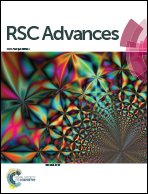Curcumin entrapped folic acid conjugated PLGA–PEG nanoparticles exhibit enhanced anticancer activity by site specific delivery
Abstract
Herein we report curcumin entrapped nanoparticles of PLGA–PEG copolymer which were conjugated with folic acid (PPF copolymer) for site specific targeting since many cancer cells exhibit external folic acid binding receptors. The PPF copolymer was synthesised by two steps using DCC/NHS chemistry and characterized by FT-IR and 1H-NMR techniques. The curcumin was encapsulated in PPF by single emulsion-solvent evaporation method. The nanoparticles were characterised by TEM and DLS for their size and morphology. The thermal properties were assessed by DSC data. In vitro release kinetics measurements of the drug from the nanoparticles showed a controlled release pattern over a period of time. The MTT assay depicted a high amount of cytotoxicity of PPF nanocurcumin in HeLa cells. Cellular uptake studies demonstrated the efficacy of surface engineering with folate over free nanoparticles. Furthermore, the biological evaluations, for example AO/EB staining, DAPI staining, and clonogenic assay of the nanoparticles confirm the efficacy and mechanism by which the cytotoxicity was induced.


 Please wait while we load your content...
Please wait while we load your content...